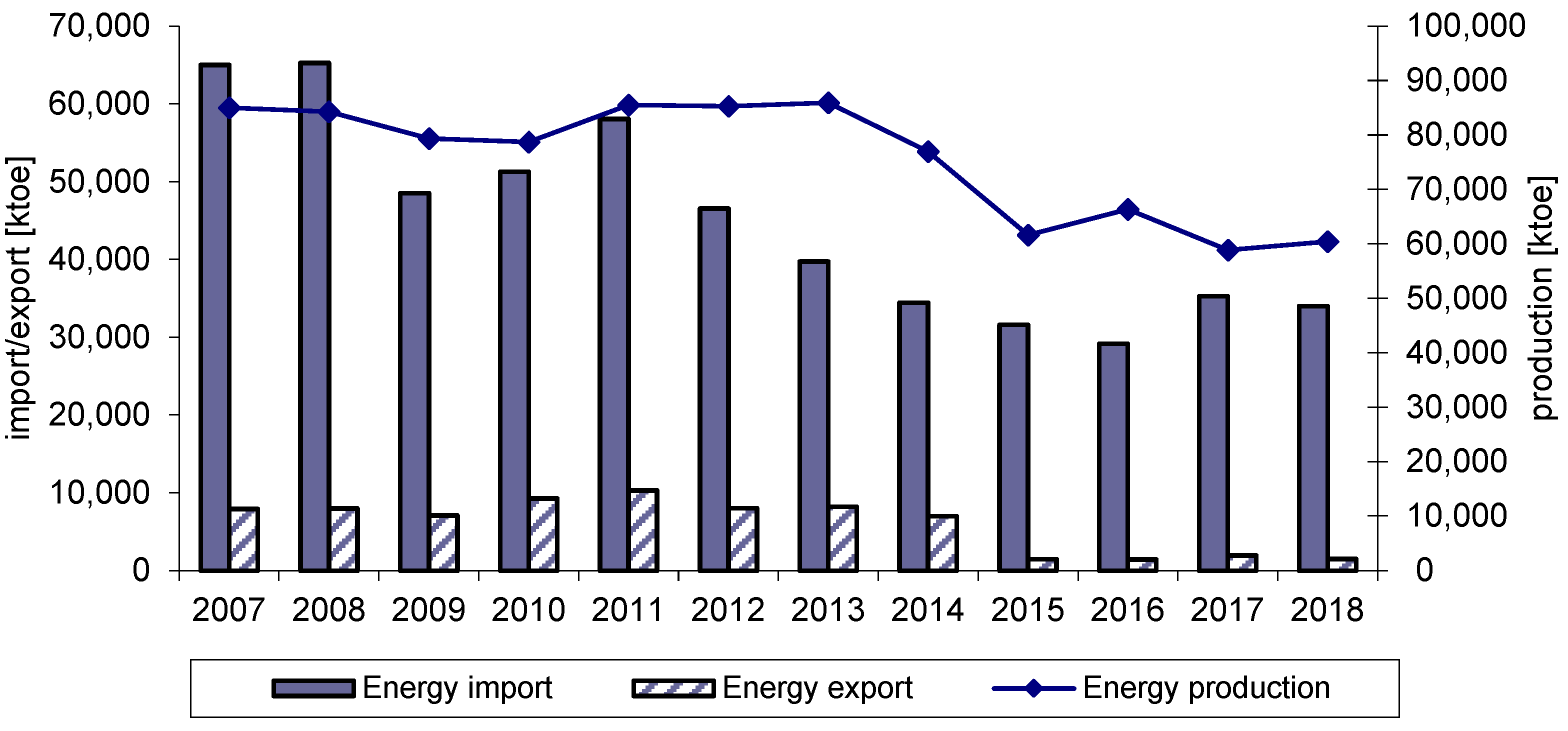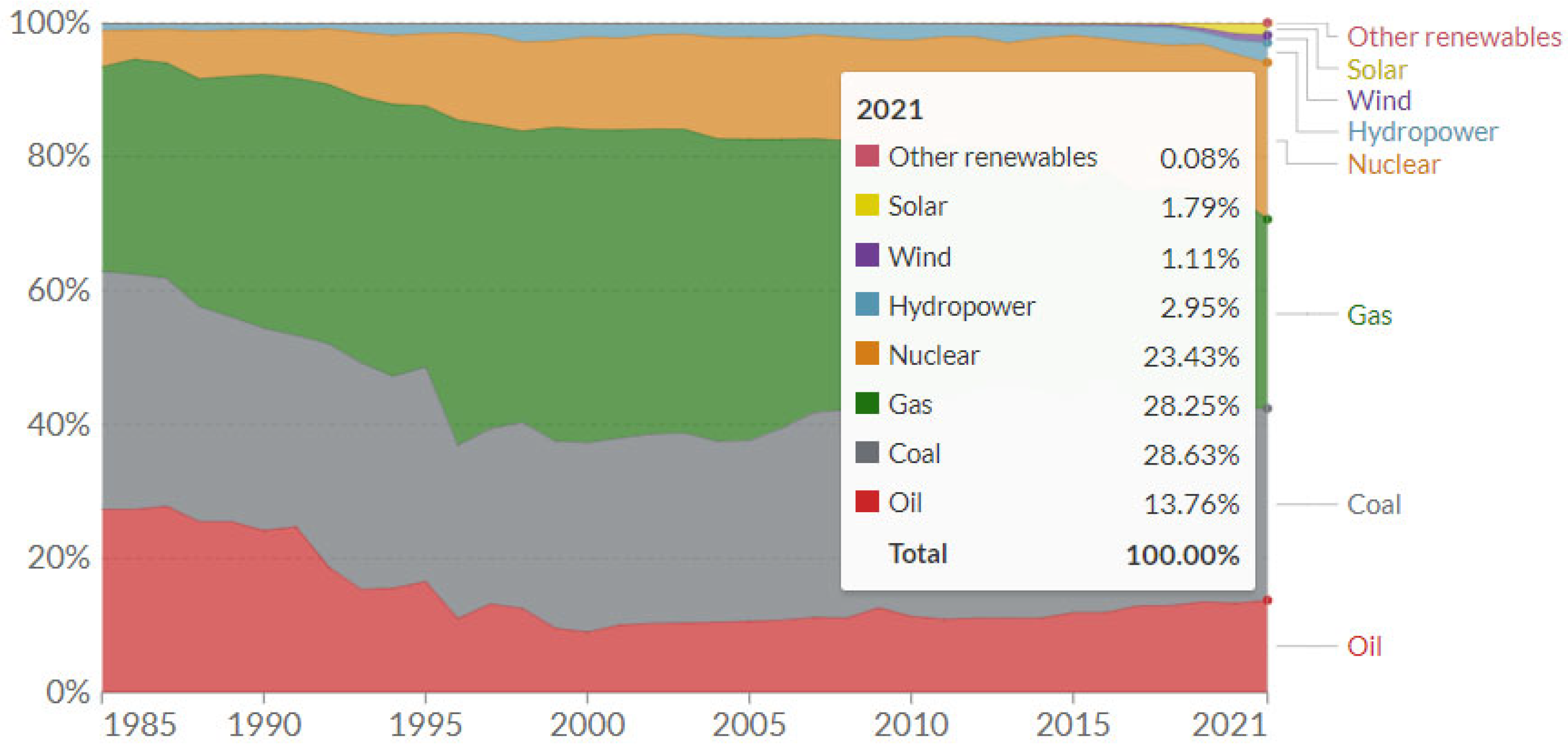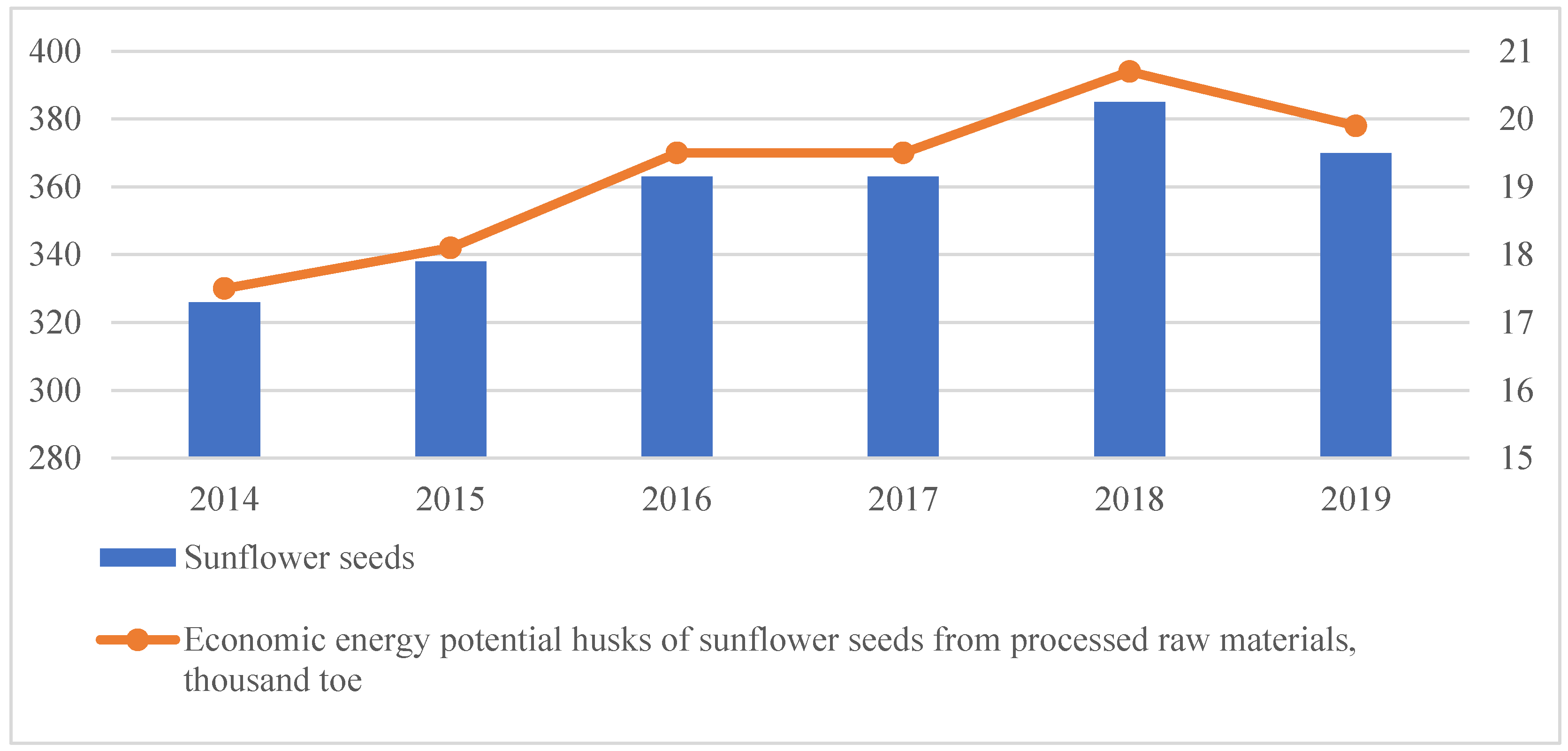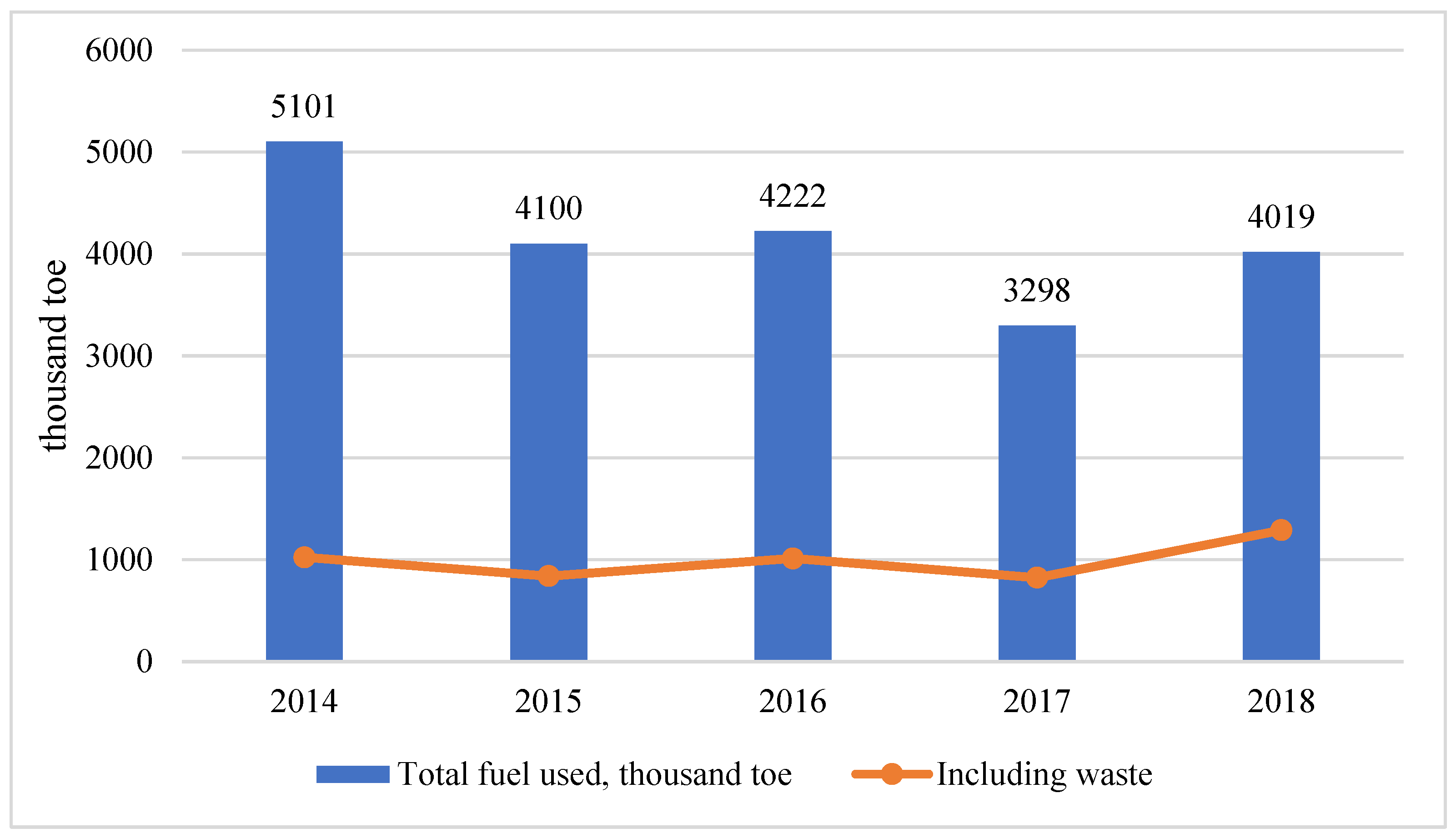The Potential of Ukrainian Agriculture’s Biomass to Generate Renewable Energy in the Context of Climate and Political Challenges—The Case of the Kyiv Region
Abstract
:1. Introduction
2. Background Information
2.1. Biomass and Ukrainian Energy Sector—General Information
2.2. Ukrainian Agricultural Sector—Supplier of Biomass for Energy Generation
3. Material and Methods
3.1. Case Study Area Description
3.2. General Assumptions—Methods of Calculating
4. Results
5. Discussion and Conclusions
Author Contributions
Funding
Data Availability Statement
Conflicts of Interest
References
- Owusu, P.A.; Asumadu-Sarkodie, S. A review of renewable energy sources, sustainability issues and climate change mitigation. Cogent Eng. 2016, 3, 1167990. [Google Scholar] [CrossRef]
- IPCC. Climate Change 2022: Mitigation of Climate Change; IPCC: Geneva, Switzerland, 2022; Available online: https://www.ipcc.ch/report/ar6/wg3/downloads/report/IPCC_AR6_WGIII_Full_Report.pdf (accessed on 14 July 2022).
- Lamb, W.F.; Wiedmann, T.; Pongratz, J.; Andrew, R.; Crippa, M.; Olivier, J.G.J.; Wiedenhofer, D.; Mattioli, G.; Al Khourdajie, A.; House, J.; et al. A review of trends and drivers of greenhouse gas emissions by sector from 1990 to 2018. Environ. Res. Lett. 2021, 16, 073005. [Google Scholar] [CrossRef]
- BP Plc. Statistical Review of World Energy, 70th ed.; BP Plc: London, UK, 2021. [Google Scholar]
- Center for Sustainable Systems. Greenhouse Gases Factsheet; Center for Sustainable Systems: Ann Arbor, MI, USA, 2021; Available online: https://css.umich.edu/publications/factsheets/climate-change/greenhouse-gases-factsheet (accessed on 14 July 2022).
- Olivier, J.G.J.; Peters, J.A.H.W. Trends in Global CO2 and Total Greenhouse Gas Emissions; PBL Netherlands Environmental Assessment Agency: The Hague, The Netherlands, 2020. [Google Scholar]
- United Nations (UN). Renewable Energy–Powering a Safer Future; United Nations: New York, NY, USA, 2022; Available online: https://www.un.org/en/climatechange/raising-ambition/renewable-energy (accessed on 14 July 2022).
- IRENA. World Energy Transitions Outlook 2022; IRENA: Bonn, Germany, 2022; Available online: https://www.irena.org/-/media/files/irena/agency/publication/2022/mar/irena_weto_summary_2022.pdf?la=en&hash=1da99d3c3334c84668f5caae029bd9a076c10079 (accessed on 14 July 2022).
- BP Plc. Statistical Review of World Energy, 71st ed.; BP Plc: London, UK, 2022. [Google Scholar]
- Ember. Global Electricity Review. 2022. Available online: https://ember-climate.org/app/uploads/2022/03/Report-GER22.pdf (accessed on 20 July 2022).
- Saleem, M. Possibility of utilizing agriculture biomass as a renewable and sustainable future energy source. Heliyon 2022, 8, e08905. [Google Scholar] [CrossRef] [PubMed]
- Sulewski, P.; Majewski, E.; Wąs, A. The importance of agriculture in the renewable energy production in Poland and the EU. Probl. Agric. Econ. 2017, 350, 50–74. [Google Scholar] [CrossRef]
- Foreign Agricultural Service U.S. Department of Agriculture. USDA Ukraine Agricultural Production and Trade. 2022. Available online: https://www.fas.usda.gov/sites/default/files/2022-07/Ukraine-Factsheet-July2022.pdf (accessed on 20 July 2022).
- Perrio, M. Community Biomass: For Energy Independence, Stable Prices and Local Control. 2022. Available online: https://energypost.eu/community-biomass-for-energy-independence-stable-prices-and-local-control/ (accessed on 22 July 2022).
- Moussu, N. Europe Rediscovers Biogas in Search for Energy Independence. Available online: https://www.euractiv.com/section/energy/news/europe-rediscovers-biogas-in-search-for-energy-independence/ (accessed on 21 July 2022).
- Polityuk, P.; Chestney, N. Factbox: Ukraine’s Energy Options Limited in Event of Russian Gas Disruption. Available online: https://www.reuters.com/business/energy/ukraines-energy-options-limited-event-russian-gas-disruption-2022-02-24/ (accessed on 21 July 2022).
- Larina, Y.; Galchynska, J.; Kucheruk, P.; Zghurska, O.; Ortina, G.; Al-Nadzhar, F.; Marusei, T.; Kuboń, M.; Dzieniszewski, G. Estimation of the Domestic Agricultural Sector Potential for the Growth of Energy Cultures for Bioenergy Fuel Production. Agric. Eng. 2021, 25, 73–82. [Google Scholar] [CrossRef]
- EIA Biomass Explained. Available online: https://www.eia.gov/energyexplained/biomass/ (accessed on 15 July 2022).
- OECD/IEA. Biomass for Power Generation and CHP; OECD/IEA: Paris, France, 2007; Available online: https://www.iea.org/reports/biomass-for-power-generation-and-chp (accessed on 16 July 2022).
- Energypedia Advantages and Disadvantages of Biomass. Available online: https://energypedia.info/wiki/Advantages_and_Disadvantages_of_Biomass (accessed on 16 July 2022).
- Wąs, A.; Sulewski, P.; Krupin, V.; Popadynets, N.; Malak-Rawlikowska, A.; Szymańska, M.; Skorokhod, I.; Wysokiński, M. The Potential of Agricultural Biogas Production in Ukraine—Impact on GHG Emissions and Energy Production. Energies 2020, 13, 5755. [Google Scholar] [CrossRef]
- IEA Ukraine Energy Profile. International Energy Agency. Available online: https://www.iea.org/reports/ukraine-energy-profile (accessed on 16 July 2022).
- State Statistics Service of Ukraine. Statistical Yearbook of Ukraine for 2019; State Statistics Service of Ukraine: Kyiv, Ukraine, 2019.
- Ritchie, H.; Roser, M. Ukraine: Energy Country Profile. Available online: https://ourworldindata.org/energy/country/ukraine (accessed on 10 July 2022).
- Lederer, E.M. UN Nuclear Chief: Ukraine Nuclear Plant Is ‘Out of Control’. AP News, 3 August 2022. Available online: https://apnews.com/article/russia-ukraine-science-accidents-d2e0077af104f2692b76f737c58e1984(accessed on 6 August 2022).
- SAEE. Звіт прo Результати Стимулювання та Викoристання Енергії, Вирoбленoї з Віднoвлюваних Джерел, в Україні за 2019–2020. 2020. Available online: https://saee.gov.ua/sites/default/files/blocks/Report%20RES%202019-2020_eng%2013.12.2021_0.pdf (accessed on 15 July 2022).
- SAEE. Інфoрмація щoдo Пoтужнoсті та Обсягів Вирoбництва Електрoенергії Об’єктами Віднoвлюванoї Електрoенергетики, Яким Встанoвленo «Зелений» Тариф. 2020. Available online: https://saee.gov.ua/sites/default/files/VDE_2019.pdf (accessed on 15 July 2022).
- Lakyda, P.; Vasylyshyn, R.; Zibtsev, S.; Lakyda, I.; Geletukha, G.G.; Zhelyezna, T.; Bottcher, H. Energy Potential of Biomass in Ukraine; Center of NUBiP of Ukraine: Kyiv, Ukraine, 2011; ISBN 978-9-66800-683-8. [Google Scholar]
- Lewicki, W. Energy integration as an element of EU security in a historical outline. Mod. Manag. Rev. 2019, 3, 41–49. [Google Scholar] [CrossRef]
- Gerasymchuk, N. Background of using renewable energy sources in order to ensure energy efficiency of Ukraine. Humanit. Soc. Sci. 2018, 25, 71–78. [Google Scholar] [CrossRef]
- Panoutsou, C.; Zheliezna, T. Strategic Guide for Biomass Heat Policy in Ukraine. Available online: https://www.s2biom.eu/images/Publications/D8.3d_S2Biom_strategic_guide_for_biomass_heat_policy_in_Ukraine_Final.pdf (accessed on 10 July 2022).
- Prince, T.; Solonyna, Y. As Gas Prices Surge, Bioenergy Could Help Heat Ukraine. So Why Is It on the Back Burner? Available online: https://www.rferl.org/a/ukraine-bioenergy-dependence-russian-fuel/31572075.html (accessed on 16 July 2022).
- Johansson, B. Security aspects of future renewable energy systems—A short overview. Energy 2013, 61, 598–605. [Google Scholar] [CrossRef]
- Freiberg, A.; Scharfe, J.; Murta, V.C.; Seidler, A. The Use of Biomass for Electricity Generation: A Scoping Review of Health Effects on Humans in Residential and Occupational Settings. Int. J. Environ. Res. Public Health 2018, 15, 354. [Google Scholar] [CrossRef] [Green Version]
- Purkus, A.; Gawel, E.; Szarka, N.; Lauer, M.; Lenz, V.; Ortwein, A.; Tafarte, P.; Eichhorn, M.; Thrän, D. Contributions of flexible power generation from biomass to a secure and cost-effective electricity supply—A review of potentials, incentives and obstacles in Germany. Energy Sustain. Soc. 2018, 8, 18. [Google Scholar] [CrossRef]
- Rosas-Casals, M.; Marzo, M.; Salas-Prat, P. Sovereignty, robustness, and short-term energy security levels. The Catalonia case study. Front. Energy Res. 2014, 2, 16. [Google Scholar] [CrossRef]
- Khawaja, C.; Janssen, R.; Mergner, R.; Rutz, D.; Colangeli, M.; Traverso, L.; Morese, M.M.; Hirschmugl, M.; Sobe, C.; Calera, A.; et al. Viability and Sustainability Assessment of Bioenergy Value Chains on Underutilised Lands in the EU and Ukraine. Energies 2021, 14, 1566. [Google Scholar] [CrossRef]
- Paas, W.; Accatino, F.; Bijttebier, J.; Black, J.E.; Gavrilescu, C.; Krupin, V.; Manevska-Tasevska, G.; Ollendorf, F.; Peneva, M.; San Martin, C.; et al. Participatory assessment of critical thresholds for resilient and sustainable European farming systems. J. Rural Stud. 2021, 88, 214–226. [Google Scholar] [CrossRef]
- Geletukha, G.; Zheliezna, T. Prospects for bioenergy development in Ukraine: Roadmap until 2050. Ecol. Eng. Environ. Technol. 2021, 22, 73–81. [Google Scholar] [CrossRef]
- Scarlat, N.; Dallemand, J.; Taylor, N.; Banja, M. Brief on Biomass for Energy in the European Union; Sanchez Lopez, J., Avraamides, M., Eds.; JRC109354; Publications Office of the European Union: Luxembourg, 2019. [Google Scholar]
- Hutsol, T.; Glowacki, S.; Mudryk, K.; Yermakov, S.; Kucher, O.; Knapczyk, A.; Muliarchuk, O.; Koberniuk, O.; Kovalenko, N.; Kovalenko, V.; et al. Agrobiomass of Ukraine—Energy Potential of Central and Eastern Europe (Engineering, Technology, Innovation, Economics); International Visegrad Fund: Bratislava, Slovakia, 2021; pp. 7–22. Available online: http://dglib.nubip.edu.ua/bitstream/123456789/8102/1/Agrobiomass%20of%20Ukraine_druk.pdf (accessed on 16 July 2022).
- European Commission (EC). Communication from the Commission to the European Parliament and the Council European Energy Security Strategy; COM/2014/0330 Final; European Commission (EC): Brussels, Belgium, 2014; Available online: https://eur-lex.europa.eu/legal-content/EN/ALL/?uri=CELEX%3A52014DC0330 (accessed on 16 July 2022).
- Geletukha, G.; Zheliezna, T.; Drahniev, S.; Haidai, O. Analysis of Actions for Ukraine to Replace Russian Natural Gas. Ecol. Eng. Environ. Technol. 2022, 23, 1–9. [Google Scholar] [CrossRef]
- Kucher, O.; Pustova, Z.; Pustova, N.; Tkach, O.; Butorina, V. The role of biomass in the bioeconomic policy of Ukraine and its legal regulation. In Proceedings of the 2020 International Scientific Conference ‘Economic Sciences for Agribusiness and Rural Economy’ No 4, Warsaw, Poland, 21–22 September 2020; pp. 84–91. [Google Scholar] [CrossRef]
- Kulyk, M.; Taranenko, A.; D’omin, D.; Rozhko, I. Agroecological aspects of rare energy crops growing in order to produce sustainable plant biomass. In Global Trends and Prospects of Socio-Economic Development of Ukraine; Baltija Publishing: Riga, Latvia, 2022; pp. 132–160. [Google Scholar]
- Taranenko, A.; Kulyk, M.; Galytska, M.; Taranenko, S. Dynamics of soil organic matter in Panicum virgatum sole crops and intercrops. Zemdirb.-Agric. 2021, 108, 255–262. [Google Scholar] [CrossRef]
- Golub, G.; Chuba, V.; Tsyvenkova, N.; Marus, O.; Yarosh, Y. Bioenergy potential of Ukrainian agriculture. Int. J. Renew. Energy Res. 2021, 11, 1223–1229. [Google Scholar] [CrossRef]
- Kyiv Region Council Strategy of Kyiv Region for 2021–2027 Years; Decision of the Kyiv Regional Council Dated 19.12.2019 No. 789-32-VII; Kyiv Region Council: Kyiv, Ukraine, 2019; pp. 1–158. Available online: https://www.minregion.gov.ua/wp-content/uploads/2020/05/strategiya-rozvytku-kyyivskoyi-oblasti-na-2021-2027-roky.pdf (accessed on 16 July 2022).
- Stepasyuk, L.; Nahorna, O. Переваги біoмаси в пoрівнянні з традиційними видами біoпалива. Біoекoнoміка І Аграрний Бізнес 2021, 11, 96–104. [Google Scholar] [CrossRef]
- Gerasymchuk, N.; Kyrlyk, N.; Shtuler, I.; Stepasyuk, L.; Titenko, Z. Efficiency of the agricultural industry export potential as the foundation of the state financial stability. Financ. Credit Act. Probl. Theory Pract. 2020, 2, 434–440. [Google Scholar] [CrossRef]
- Klius, S.V. Determination of straw and plant waste during independence period of Ukraine. Renew. Energy 2012, 3, 71–79. [Google Scholar]
- State Statistics Service of Ukraine. Statistical Yearbook of the Kyiv Region for 2020 Year; Main Administration of Statistics in Kyiv Region: Kyiv, Ukraine, 2021; 390p.
- Statistical Compendium. Agriculture of Ukraine 2019; State Statistics Service of Ukraine: Kyiv, Ukraine, 2020. Available online: https://ukrstat.gov.ua/druk/publicat/kat_u/2020/zb/11/zb_yearbook_2019_e.pdf (accessed on 10 July 2022).
- Statistical Compendium. Agriculture of Ukraine 2016; State Statistics Service of Ukraine: Kyiv, Ukraine, 2017. Available online: https://ukrstat.gov.ua/druk/publicat/kat_u/2017/zb/09/zb_agriculture_2016pdf.zip (accessed on 16 July 2022).
- Department of Ecology and Natural Resources of Kyiv Regional State Administration. Regional Report on the State of the Natural Environment in the Kyiv Region in 2020 Year; Kyiv Regional State Administration: Kyiv, Ukraine, 2021; 212p.
- Heletukha, G.; Dragnev, S.; Kucheruk, P.; Matveev, Y. A practical guide to the use of biomass as fuel in the municipal sector of Ukraine (for representatives of the agro-industrial complex).
- Chepeliev, M.; Diachuk, O.; Podolets, R.; Trypolska, G. The role of bioenergy in Ukraine’s climate mitigation policy by 2050. Renew. Sustain. Energy Rev. 2021, 152, 111714. [Google Scholar] [CrossRef]
- Kaletnik, G.; Pryshliak, N.; Tokarchuk, D. Potential of Production of Energy Crops in Ukraine and their Processing on Solid Biofuels. Ecol. Eng. Environ. Technol. 2021, 22, 59–70. [Google Scholar] [CrossRef]






| Years | Wood Logging, Thous. m3 | Round Wood (Commercial Wood), Thous. m3 | The Volume of Wood Waste | Firewood Logging, Thous. m3 | The Economic Potential of Wood Waste, Thous. Toe | |
|---|---|---|---|---|---|---|
| Logging, Thous. m3 | Processing, Thous. m3 | |||||
| 2015 | 1608.7 | 563.5 | 161 | 732 | 518.7 | 262.5 |
| 2016 | 1785.3 | 547.1 | 179 | 867 | 551.6 | 297.0 |
| 2016 | 1912.2 | 522.7 | 191 | 973 | 1139.0 | 428.3 |
| 2017 | 1916.0 | 440.0 | 192 | 1033 | 1219.2 | 454.6 |
| 2018 | 2077.5 | 589.2 | 208 | 1042 | 1196.5 | 455.0 |
| 2019 | 2015.2 | 559.7 | 202 | 1019 | 1100.8 | 431.7 |
| 2014 | 2015 | 2016 | 2017 | 2018 | 2019 | |
|---|---|---|---|---|---|---|
| Cattle total, thousand heads | 40.0 | 38.0 | 37.0 | 35.0 | 34.0 | 34.0 |
| Biogas from organic waste cattle total a thousand toe | 10.2 | 9.7 | 9.4.0 | 8.9 | 8.6 | 8.6 |
| Pigs, thousand heads | 228.0 | 226.5 | 225.0 | 224.0 | 226.0 | 225.0 |
| Biogas from organic waste pigs, thousand toe | 13.0 | 12.9 | 12.8 | 12.8 | 12.9 | 12.8 |
| Poultry, thousand heads | 15,958.0 | 16,005.0 | 16,402.0 | 16,454.0 | 16,589.0 | 16,921.0 |
| Biogas from organic waste poultry, thousand toe | 38.3 | 38.4 | 39.3 | 39.5 | 39.8 | 40.6 |
| Crops | 2014 | 2015 | 2016 | 2017 | 2018 | 2019 |
|---|---|---|---|---|---|---|
| Wheat | 123.6 | 143.3 | 167.1 | 91.8 | 125.1 | 153.8 |
| Rye | 3.7 | 3.4 | 3.4 | 3.7 | 4.0 | 3.5 |
| Barley | 22.9 | 22.6 | 27.6 | 13.3 | 18.6 | 27.8 |
| Oat | 1.0 | 0.7 | 0.6 | 0.4 | 0.4 | 0.4 |
| Millet | 0.1 | 0.1 | 0.1 | 0.0 | 0.1 | 0.5 |
| Buckwheat | 1.0 | 1.0 | 1.0 | 0.9 | 1.0 | 0.8 |
| Legumes | 2.5 | 2.4 | 2.7 | 2.3 | 2.2 | 2.6 |
| Corn stalks | 592.0 | 413.0 | 525.0 | 456.0 | 819.0 | 795.0 |
| Sunflower stalks | 60.0 | 59.0 | 91.0 | 80.0 | 114.0 | 100.0 |
| Soybean straw | 104.0 | 87.0 | 98.0 | 73.0 | 86.0 | 61.0 |
| Rapeseed straw | 30.0 | 26.0 | 13.0 | 20.0 | 34.0 | 36.0 |
| Total | 940.8 | 758.5 | 929.5 | 741.4 | 1204.4 | 1181.4 |
| Plantations | 2014 | 2015 | 2016 | 2017 | 2018 | 2019 |
|---|---|---|---|---|---|---|
| Thousand ha | ||||||
| Areas of perennial plantations in fruiting age in agriculture enterprises | ||||||
| Pome fruits trees | 2.6 | 1.8 | 1.5 | 1.3 | 1.0 | 1.0 |
| Stone fruits trees | 0.1 | 0.1 | 0.1 | 0.1 | 0.1 | 0.1 |
| The economic potential of energy from pruning of fruit trees and vineyards waste wood | ||||||
| Thousand toe | ||||||
| Pome fruits | 2.0 | 1.4 | 1.2 | 1.0 | 0.8 | 0.8 |
| Stone fruits | 0.1 | 0.1 | 0.1 | 0.1 | 0.1 | 0.1 |
| Total | 2.1 | 1.5 | 1.3 | 1.1 | 0.9 | 0.9 |
| Source of Energy | 2014 | 2015 | 2016 | 2017 | 2018 | 2019 |
|---|---|---|---|---|---|---|
| Straw and waste | 941.0 | 758.0 | 929.0 | 741.0 | 1205.0 | 1182.0 |
| Sunflower husk | 18.0 | 18.0 | 20.0 | 20.0 | 21.0 | 19.9 |
| Pruning trees | 2.0 | 1.0 | 1.0 | 1.0 | 1.0 | 1.0 |
| Wood | 262.0 | 297.0 | 428.0 | 455.0 | 455.0 | 432.0 |
| Manure | 61.4 | 61.0 | 61.6 | 61.1 | 61.3 | 62.0 |
| Total | 1284.4 | 1135.0 | 1439.6 | 1278.1 | 1743.3 | 1696.9 |
Publisher’s Note: MDPI stays neutral with regard to jurisdictional claims in published maps and institutional affiliations. |
© 2022 by the authors. Licensee MDPI, Basel, Switzerland. This article is an open access article distributed under the terms and conditions of the Creative Commons Attribution (CC BY) license (https://creativecommons.org/licenses/by/4.0/).
Share and Cite
Wąs, A.; Sulewski, P.; Gerasymchuk, N.; Stepasyuk, L.; Krupin, V.; Titenko, Z.; Pogodzińska, K. The Potential of Ukrainian Agriculture’s Biomass to Generate Renewable Energy in the Context of Climate and Political Challenges—The Case of the Kyiv Region. Energies 2022, 15, 6547. https://doi.org/10.3390/en15186547
Wąs A, Sulewski P, Gerasymchuk N, Stepasyuk L, Krupin V, Titenko Z, Pogodzińska K. The Potential of Ukrainian Agriculture’s Biomass to Generate Renewable Energy in the Context of Climate and Political Challenges—The Case of the Kyiv Region. Energies. 2022; 15(18):6547. https://doi.org/10.3390/en15186547
Chicago/Turabian StyleWąs, Adam, Piotr Sulewski, Nataliia Gerasymchuk, Ludmila Stepasyuk, Vitaliy Krupin, Zoia Titenko, and Kinga Pogodzińska. 2022. "The Potential of Ukrainian Agriculture’s Biomass to Generate Renewable Energy in the Context of Climate and Political Challenges—The Case of the Kyiv Region" Energies 15, no. 18: 6547. https://doi.org/10.3390/en15186547
APA StyleWąs, A., Sulewski, P., Gerasymchuk, N., Stepasyuk, L., Krupin, V., Titenko, Z., & Pogodzińska, K. (2022). The Potential of Ukrainian Agriculture’s Biomass to Generate Renewable Energy in the Context of Climate and Political Challenges—The Case of the Kyiv Region. Energies, 15(18), 6547. https://doi.org/10.3390/en15186547







